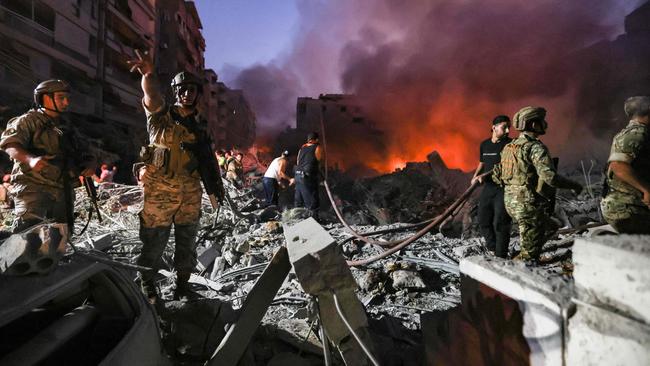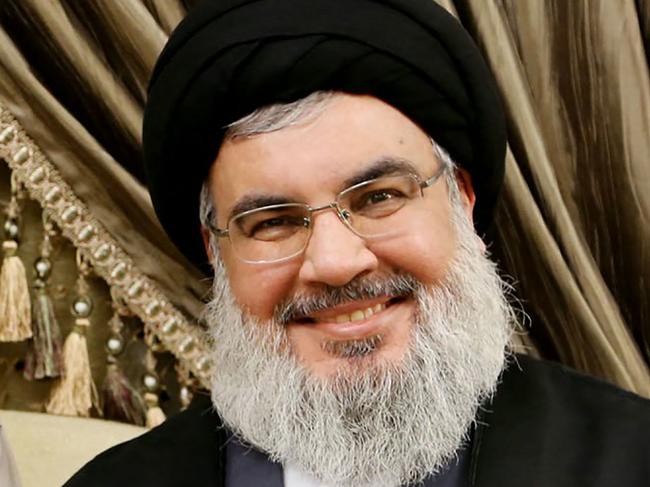Benjamin Netanyahu knew facing UN General Assembly set Hassan Nasrallah up for fatal strike
When Benjamin Netanyahu faced the UN General Assembly, he had just minutes before approved one of the biggest single airstrikes on a major city in recent history.

When Benjamin Netanyahu faced the UN General Assembly, his emphatic and combative tone was a clue that Israel would not sign off on a 21-day ceasefire proposed by the US and France.
Unbeknown to the delegates in the room, and those who had walked out in protest, just minutes before in his New York hotel room the Israeli Prime Minister had already approved one of the biggest single airstrikes on a major city in recent history.
Mr Netanyahu had told his military leaders that Operation New Order, to eliminate the founder and head of Hezbollah, Hassan Nasrallah, was “a go”.
Israeli intelligence had known of the whereabouts of Nasrallah for months, and his elimination was part of the bigger plan to not only paralyse his Iranian proxy terrorist organisation but to dismember it, analysts say.
Military officials had already identified how to pierce Nasrallah’s underground bunker in southern Beirut with a series of timed explosions, with each blast paving the way for the next one. The exact timing of the strike, Israeli officials said, was opportunistic, coming after Israeli intelligence learned about a meeting of Nasrallah and his senior leaders only hours before it occurred.
So last Friday night Nasrallah, in his bunker 20m underground, was watching Mr Netanyahu tell the world “there is no place in Iran that the long arm of Israel cannot reach”. Alongside the Hezbollah leader was Brigadier General Abbas Nilforoushan, the head of operations in Lebanon for Iran’s Islamic Revolutionary Guard Corps. Whether these two were plotting to restore Hezbollah’s fighting force, or Iran stepping up with more weapon deliveries and the dispatch of more men, or unleashing the long-range missiles stored across Lebanon, or deciding on new strategies against Israel, none of this may now not be known. Yet Nasrallah will have sensed Mr Netanyahu’s defiance of a Western-back compromise coming from the big television screen in his subterranean bunker.

Israel would “continue degrading Hezbollah until all our objectives are met”, Mr Netanyahu said. “We will not accept a terror army parked on our northern border.”
There had been Arab speculation that Nasrallah was becoming too timid and fearful in his response to Israel’s pager and walkie-talkie blasts, which had killed and maimed around 1000 Hezbollah commanders a week earlier. Those unexpected and co-ordinated explosions had shaken Iran too: their ambassador to Lebanon, Mojtaba Amani, had lost an eye, and clearly Israel had infiltrated the organisation with inside intelligence.
Hezbollah had responded by intensifying the barrage of 8000 rockets that it had fired into northern Israel since the day after the October 7 massacre and hostage-taking by Hamas – but Israel was now threatening a ground invasion to ensure more than 60,000 displaced Israeli residents could return to their homes.
Nasrallah and General Nilforoushan weren’t about to have Israeli boots cross the border.
And then, at dusk on Friday evening, the big bombs fell.
Residents of Beirut describe a shaking of the ground 30km away as huge plumes of smoke rose high above the city about 6.30pm (1.30am on Saturday AEST). Israel had unleashed 80 tonnes of bombs within minutes in a highly targeted operation on a small area of Dahiyeh, the Hezbollah stronghold in a southern suburb of the capital.

The Americans, still pushing for a ceasefire, were caught unprepared. It was only as the Israeli jets were in the air heading to Lebanese airspace that the US administration was informed of the attack.
Amid chaotic scenes on the ground, with residents fleeing and rescue workers bringing in excavators and floodlights, it became apparent that Mr Netanyahu’s plan, going to New York to make the speech, increasing the odds that Nasrallah would be in his underground bunker, had worked.
Israeli air force jets “conducted a targeted strike on the central headquarters of the Hezbollah terrorist organisation, which was located underground embedded under a residential building in the area of Dahiyeh in Beirut,” the Israeli Defence Forces said.
“The strike was conducted while Hezbollah’s senior chain of command were operating from the headquarters and advancing terrorist activities against the citizens of the state of Israel.”
The bombs were devastatingly effective in flattening the block of six buildings. The level of destruction made it difficult for experts to determine the exact munitions used by the Israelis but everyone agrees they were “bunker busters” that penetrate deep into the ground before exploding.
Military analyst Elijah Magnier said the Israelis had used the latest version, GBU-72 bombs, which are 5000-pounders. Mr Magnier told Al Jazeera that Israel wanted to ensure “nobody” came out alive.
Former US Army explosive ordnance disposal expert Trevor Ball told CNN it looked like multiple 2000-pound bombs, Mk 84s, MPR-2000, or BLU-109 bunker busters “or a combination of them”.
To those who witnessed the destruction, it was clear that Nasrallah and the senior commanders with him, including a possible Hezbollah successor Ali Kraki, had perished, but it would take Hezbollah more than 15 hours to issue a confirmation.
The first suggestion that their leader was not “in good health” and not “in a safe place”, as first described by the Hezbollah media office, came from Iran some hours after the attack.
Ali Larijani, an adviser to Iran’s Supreme Leader Ayatollah Ali Khamenei, told state TV that Israel was inflaming tensions. “Assassinations will not solve Israel’s problem ... With the assassination of resistance leaders, others will take their place,” he said.

Once Mr Netanyahu had returned to Tel Aviv – escorted by military jets across the Atlantic, landing at Ben Gurion airport as another Iranian proxy, the Houthis, fired a missile towards it – the Israelis announced they had confirmed Nasrallah’s death.
Not long after that, Hezbollah said Nasrallah had been killed, describing him as “a great martyr, a heroic, daring, brave, wise, insightful and faithful leader”.
Israel army chief Herzi Halevi said the program of attacks against Hezbollah required a “long time of preparation”.
He said in a video message that the military had developed many “capabilities” to deal with Hezbollah.
The strike, Lieutenant General Halevi said, “was carried out at the right time, in a very sharp manner, and we are now moving to preparing the next things”.
General Halevi warned that Israel had not completed its goals. “This is not the end of our toolbox,’’ he said. “It should be very clear: there are further tools going forward. And the message is clear: anyone who threatens the citizens of Israel, we will know how to reach them, in the north, in the south, and also farther away”.
Mr Netanyahu said Israel had “settled the score” by killing Nasrallah and had reached a historic turning point in the fight against Israel’s enemies. He insisted that Hamas leader Yahya Sinwar would see that Hezbollah would no longer come to his aid in Gaza, increasing the chances of returning the Israeli hostages.
In a clear message to Iran, he said Israel was “determined to continue striking our enemies”.




To join the conversation, please log in. Don't have an account? Register
Join the conversation, you are commenting as Logout